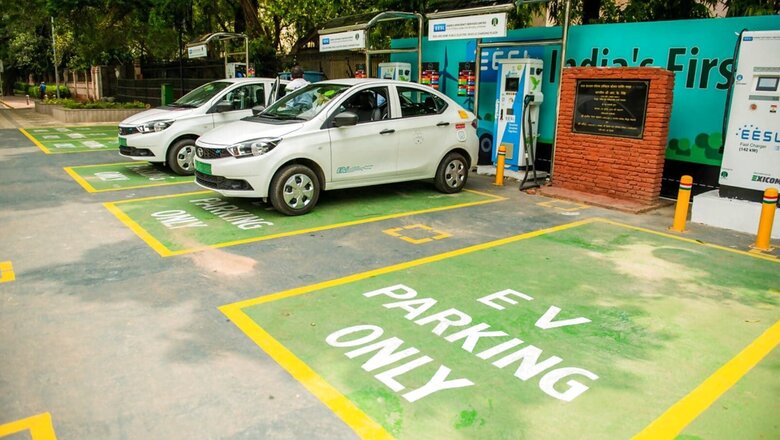
views
Increase in fuel prices and a push from the government are behind the rise in sales of electric automobiles in India though two- and three-wheelers still dominate the market as compared to four-wheelers.
On World EV Day, News18 spoke to a few industry leaders and experts who shed light on the growing trend in the Indian market.
The Popularity
Deepak Pahwa, Managing Director at Bry-Air, said Electric Vehicle (EV)s are the way of the future and India is considering the potential of generating an increasing number of EVs in the country.
According to him, along with India, other countries are focusing on EVs and ‘battery’ is the driving force.
However, while talking about trends, Visakh Sasikumar, CEO & Founder of Fyn, stated that India is predominantly a two-wheeler market and a front runner in two-wheeler transport sales all over the world even ahead of China.
Sasikumar cited a report by UnivDatos Market Insights and noted that Indian two-wheeler market unit sales stood at 21.2 million units in 2019 and are expected to reach 26.6 million units by 2025, displaying a reasonable CAGR of 2.6% over the forecast period (2020-2025).
He said: “The manufacturing of EVs in India also started with two-wheeler transports and has seen rapid adaptation with the switch to EVs growing faster than anticipated. India’s two-wheeler EV sales are forecast to grow at a CAGR of 25% by 2025.”
He added: “The two-wheeler B2C sector in India is slowly becoming aware of the benefits of switching to EVs and is taking action in the same direction. While the B2C sector slowly adapts to this shift and has their own setbacks with trusting the EV space due to mishaps such as battery fires, they are slowly regaining their trust by seeing the growth in the B2B sector’s adoption.”
Furthermore, he applauded the government’s push to increase EV popularity and said that India’s EV fleet adoption not only brings more such vehicles to Indian roads much faster but also has a significant impact on the country’s sustainability and green future.
According to him: “This boom has catered to many start-ups in the EV sector to flourish through ‘Make in India’ and seen a rise in the investments. The two-wheelers and three-wheelers are not only ushering in the rise of EV in India but are also boosting the confidence of the customers to make that switch sooner.”
Amit Gupta, CEO and Co-founder of Yulu, told News18 that both two-wheelers and three-wheelers have different reasons for their lead on the adoption curve.
He said: “One simple reason is that they started on this journey before other categories. As a result, in both categories, there are some proof points available on the value and advantage they offer over full ownership cycle.”
He noted: “For three-wheelers, a big reason is the policy push through subsidies both at central and state levels helped lower the entry barrier and then the operating economics took over.”
Gupta stated that both categories lend themselves well to new business models such as Mobility-as-a-Service, which is another driver of their growth, as Indian customers are price and utility aware when it comes to mobility.
So, according to him, as a result, electric two- and three-wheelers are widely accessible, affordable, and applicable to a wide range of Indian use cases, fueling the country’s EV boom.
Mayank Jain, Director at Crayon Motors, also stated that the Indian consumer is price conscious and seeks the best value for money, which EVs deliver, while the vehicles also have the biggest possible influence on vehicular pollution.
Apart from electric two-wheelers, according to him: “Three-wheelers have gained traction, with increased acceptance by e-commerce players and retailers for last-mile transportation. The low running cost of EVs allows e-commerce companies, retailers, and small businesses to rationalise their transportation costs.”
He added: “In addition, we are seeing rising demand and strong traction for electric four-wheelers and bus segments too. A pleasant situation like that will help to improve the EV infrastructure even more.”
A spokesperson from Zypp told News18 that rising petrol prices and emissions forced the government to shift logistics from ICE to EVs, and fleet operators like them took the initiative and worked on it on a large scale, aided by programmes like FAME, which provides subsidies for purchasing an EV.
He also stated that FAME saved a lot of money and reduced the cost of acquisition for fleet operators, delivery executives, and end customers alike.
“The key reason for the EV boom is higher driver earnings and better pricing of delivery for customers due to the advantages of running EVs,” he noted.
No to Cars?
It is noticed that electric cars or some luxury vehicles like Tesla hardly trigger massive excitement among potential EV buyers in India.
Regarding the trend, Yulu’s CEO Gupta said: “Indian consumers are price and utility conscious when it comes to mobility. Owning a high-end electric vehicle is a difficult proposition for many. What the majority of India wants is an e-mobility option that is seamless, sustainable and fulfils their daily commute requirements affordably.”
Nitin Kapoor, Managing Director of Saera Electric Auto Private Limited, said there are many factors which are impacting the sale of electric cars although the demand has picked up considerably.
According to him: “The major causes are charging infrastructure in the nascent stage and comparatively high ownership costs. Also, consumers are not fully aware of the long-term benefits of EVs.”
The Zypp spokesperson stated that luxury cars are a niche segment and not everyone will buy costly EVs in India. One major reason is also the network of charging stations and rapid charging technology which is still in its nascent stage and a lot of work is going on.
“As we have the right policies and investments to advance our charging and production cost, we are sure that luxury EV cars will pick up in the coming years. Also, it’s a lot of government focus on indigenization which will force all global OEMs to set up shops in our large country,” the spokesperson added.
Sasikumar from Fyn noted that a deterrent in electric cars not being popular is the lack of infrastructure to support the EV shift.
“If EVs are the future, the charging infrastructure is the backbone of this future. Currently, there are about 1,700+ charging stations in India and most of those are concentrated in the urban areas,” he added.
As per Sasikumar, the government is encouraging companies to build on this infrastructure, as well as urging more start-ups to grow in this space to support the EV shift and without proper infrastructural support, it will be a slow shift, especially in the four-wheeler space.
What Else Can be Done?
Mahua Acharya, MD and CEO of CESL, which has been working with some state governments to increase the number of charging stations in Indian cities, said: “At the very outset, pricing of electric commercial vehicles needs to be at par with commercial vehicles powered by hydrocarbons, as on date, there is a price disparity which dissuades State Transport Undertaking (STUs) from purchasing electric vehicles.”
She believes that government support is needed in the reduction of state and national duties and charging infrastructure needs to be upped, by both state and central governments.
She also said: “Charging stations need to be installed in all major business and financial hubs. Installation of charging hubs needs to increase along national highways to further push viability of e-buses plying on inter-city routes.”
Kapoor from Saera Electric Auto also believes that robust charging infrastructure is the precondition for a successful transport transition from ICE to EV.
“The EV industry also seeks modifications in FAME Phase 2, revision in GST which should not be more than 5%, and additional tax benefits. Moreover, EV loans at low-interest rates from banks and NBFCs can significantly impact EV popularity in India,” he added.
As per the Zypp spokesperson, “We’re sure of one thing; logistics will go all-electric at the earliest. With schemes like FAME and PLI in place, we will see a spike rise in adoption and decline in cost of acquisition.”
It was also stated that with the growing number of EVs, there will be a greater emphasis on interoperability, rapid charging, and standardisation in EV charging points, as well as an increase in EV roaming, which will enhance the EV ecosystem and make people feel more connected, confident, and empowered to adopt them.
Additionally, the spokesperson suggested: “Government is doing good work in popularising EVs in India and making EVs more affordable. We request the government to nationally mandate last mile delivery to 1st go electric 100% within a certain time frame and I think that will give a big boost & set a strong step for EV adoption in the entire country.”
However, Jain from Crayon Motors believes that the ease of retail financing can help propel EVs forward. While EVs are becoming more popular, economies of scale remain elusive.
He said: “While EVs are growing, the economies of scale are still a bit distant. Technology development is expensive.”
Additionally, the industry insider stated: “Government can use its resources to help develop indigenous shared technologies that manufacturers can use to further fasten adoption while reducing the upfront cost of the vehicle. Such an initiative will pay for itself as it will help reduce import dependence.”
Fyn’s Sasikumar stated that with mandates for delivery and last-mile businesses to become 100% green by 2030 to subsidies offered to companies & start-ups in the EV sector, the government has already taken a huge stand in supporting this paradigm shift.
“While these subsidies will help companies grow faster in the short term, we still need the government to start building on the infrastructure to support this change. Only with the right infrastructure will a country be able to make this switch much faster and be able to reach its goal of a ‘Green India’ rapidly,” he added.
Co-founder of eRise Mithlesh Jain suggested that the government needs to double down on not just providing incentives but also setting up standardizations, protocols and safety norms to ensure this gap reduces quickly and turns the corner in overtaking ICE vehicle dependence.
He also said: “There are fewer FinTech and NBFCs in the country that provide financial services to consumers because they are concerned about resale value because there is no secondary market for EVs at the moment.”
“The government must create a framework for this and mobilize financing for electric vehicles. Govt should give special relaxation in income tax to dealers of EVs and also provide finance to run dealership,” he added.
However, Nawneet Vibhaw, Partner Environment Law, Shardul Amarchand Mangaldas & Co, said that with the concerns around the shortage of lithium (used in the most popular EV battery known as Li-ion), India has the opportunity to explore and develop the alternatives like sodium-ion batteries and other technologies which would help it leapfrog ahead of the developed economies and transform faster into a nation prioritising clean mobility, including clean public transport.
Furthermore, he said: “The government needs to have norms in place to ensure that the EV is safe for commuters. The new rules to manage battery waste are a step in the right direction and will help resolve issues relating to the management of all types of battery waste.”
He added: “EV technology is expensive and therefore climate change funds meant to help achieve Net Zero should support these initiatives.”
Read all the Latest Auto News and Breaking News here


















Comments
0 comment